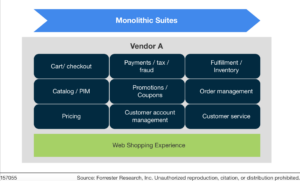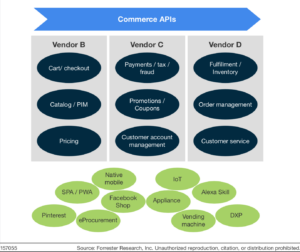Headless Commerce And The Horseless Carriage
As with any high-consideration purchase, there’s an expectation of a bedside manner. Buying an eCommerce platform is no exception. But all too often, I hear it feels a lot like this doctor’s visit . . .
Nurse tells me you’re losing sleep. The pain in your shoulder is a case of a brachial plexus avulsion. A myelography should confirm it. If you don’t want to go that route, you can do a nerve conduction study instead. Some people refer to that as electromyogram. I’m here to be flexible, so I can offer whichever you’re more comfortable with. <smiles warmly> What will it be?
Your shoulder hurts — what’s the treatment? While that information may be true, it’s not helpful. In fact, it’s downright frustrating. Spend a few hours Googling “headless commerce,” and the only part of your brain that knows what to do next is your medulla oblongata.
We have a situation in eCommerce that’s not unique in the history of innovations. There was a time when people needed the term “horseless carriage” to understand what an automobile meant for society. But at some point, we should update our mental model. Remember that Jerry Seinfeld bit, “Why do we even use the term ‘horsepower’? Is that to further humiliate horses? The space-shuttle rockets have 20 million horsepower. Is there any point in still comparing it . . . to the horses?”
So what is it, “headless commerce”?
APIs.
End of blog.


Shouldn’t We Understand How We Got To The Point Of Needing A Term In The First Place?
In 2013, the Forrester report “Content And Commerce: The Odd Couple Or The Power Couple?” called out eCommerce vendors for not keeping up with the tooling needed by digital experience practitioners. One of the proposed solutions was to let the content management system be loosely coupled to the eCommerce system. When you do that, your beautiful marketing content seamlessly flows into “add to cart” and “checkout.”
This was the first of many components to get broken out of the monolith of eCommerce platforms. The pattern? eCommerce systems provide APIs to the experience layer.
What Else Could This Solve?
That would allow me to write an iPhone app for shopping.
Right now I’ve got one website for desktop and this other one for mobile-responsive pages — they could both use the same commerce APIs.
I’ve got a kiosk . . . I’ve got a call center, too.
Shouldn’t my vendor release an upgrade to support all of these?
Oh wait — then I’ll need to upgrade. <looks at next 12 months of other stuff to do>
Wondering if anyone you know had this problem? If you’re familiar with Adobe.com, you’ll find Darin Archer’s account of the company’s journey very interesting.
What Did Vendors Do About This?
Savvy vendors saw the problem . . . but the market was accustomed to buying packaged suites. Put yourself in your own shoes seven years ago and imagine hearing this from a sales team: “It’s simple. I sell you the commerce stuff, then you go buy the experience layer from someone else and the tax system from someone else and the payments system from someone else.”
Seven years ago, you knew what tax and payment systems were . . . but what’s this eCommerce application that doesn’t come with (wait for it) the website included?
Were you looking forward to asking your CFO for money to buy an eCommerce system that doesn’t include a website?
What Are You Buying?
Words work magic in situations like this because they allow people to reason through problems.
Dirk Hoerig offered the term “headless commerce” in 2013. And it stuck. Kinda.
It Stuck With One Crowd
It stuck with the practitioners who were neck-deep in projects (pun intended).
These were the folks who’d been decoupling commerce systems from the in-monolith experience features — and making good money and creating great outcomes.
It stuck because it was part of their daily lives building next-generation experiences.
What Kind Of Experiences Were They Building?
- Toilet valves with internet of things (IoT) devices that send service orders when they’ve nearly reached their maximum number of flushes.
- Pod-based coffee makers that send replenishment orders when they know you’re out of inventory — that also make recommendations based on your taste profile for private-label offerings with higher margins — and that also give loyalty points for sales of brands’ pods for use in-store.
- Vending machines (with IoT devices) in auto body shops that sell the gloves, rags, and tools the mechanics wear through regularly — that send the order that charges the body shop — and that keep track of real-time inventory levels to simplify replenishment.
When knowing kung fu gives you a competitive advantage, how incentivized are you to open a school?
What Did I Learn After Tracking This Yeti For A Few Months?
The only thing that matters is ending the confusion and convincing businesses to catch up — fast!
Here Are Some Takeaways
- Your business and technical teams need to speak the same language. Get your terminology straight. Talk about commerce and content like you talk about APIs.
- It’s only the commerce and content vendors that use the term “headless,” and that’s because of their unique history. Social networks, banks, and everyone else just talk about their APIs.
- There’s a “headless” architecture — which is a commerce system composed of capabilities exposed as APIs.
- There’s a “headless” vendor — which is a provider of capabilities exposed as APIs.
- Screens and devices are everywhere, and they use APIs. Future-proofing yourself means leveraging APIs as the means of offering and transacting your products and services.
- And finally, the experiences that are possible to bring to life with this architecture are beyond what you (most likely) can imagine.
Check out my new report, “The New Commerce Revolution: Off With Their Heads (Or Not!),” to head off the chaos that awaits unprepared organizations. You’ll understand the essentials and you’ll be able to ask the tough questions of your vendors.
